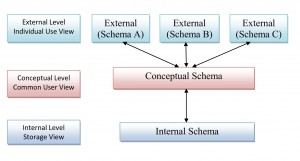Data Base Management System Architecture (DBMS)
DBMS is program or group of programs that work in conjunction with the operating system to create, process, store, retrieve, control and manage the data.The architecture is a framework for describing database concepts and specifying the structure of database system. DBMS architecture is the way in which the data in a database is viewed (or represented to) by users
The American National Standard Institute terminology and architecture in 1975, ANSI-SPARC recognized the need for a three level approach with a system catalog.
There are following three levels or layers of DBMS architecture:
- External Level
- Conceptual Level
- Internal Level
1. External Level
The external level is concerned with individual users. This is the uppermost level in the database. The external level is what allows a user to access a customized version of the data in your database. Multiple users can work on a database on the same time because of it. The external or view level includes a number of external schemas or user views. Each external schema describes the part of the database that a particular user group is interested in and hides the rest of the database from that user group.
2. Conceptual Level
This level describes what data is stored in the database and the relationships among the data. The middle level in the three level architecture is the conceptual level. This level contains the logical structure of the entire database as seen by the Data base administrator. The conceptual schema hides the details of physical storage structures and concentrates on describing entities, data types, relationships, user operations, and constraints.
3.Internal Level
The internal level has an internal schema, which describes the physical storage structure of the database. The internal schema uses a physical data model and describes the complete details of data storage and access paths for the database. The internal level is the lowest level in a three tiered database. This level deals with how the stored data on the database is represented to the user. This level shows exactly how the data is stored and organized for access on your system. This is the most technical of the three levels. However, the internal level view is still abstract –even if it shows how the data is stored physically, it will not show how the database software operates on it.
Advantages of the Three Tiered ANSI-SPARC Architecture
The ANSI-SPARC standard architecture is three tiered- that is, there are three levels through which it is represented. This three tiered representation offers several advantages, which as follows:
- It makes the database abstract. It hides the details of how the data is stored physically in an electronic system, which makes it easier to understand and easier to use for an average user. It also allows the user to concentrate on the data rather than worrying about how it should be stored.
- Each user is able to access the same data but have a different customized view of the data as per the requirement.
- The changes to physical storage organization does not affect the internal structure of the database e.g moving the database to new storage device.
- The model also allows a database admin to make changes to the database structure or make upgrades to it without disturbing a user currently on the system.
- The model allows a database admin to change the storage medium of the database without disturbing a user who is currently on the system.


